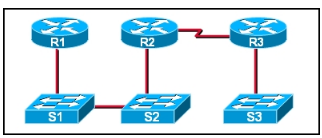READ Free Dumps For CISCO- 100-105
| Question ID 14463 | Which characteristics are representative of a link-state routing protocol? (Choose three.)
|
| Option A | provides common view of entire topology
|
| Option B | exchanges routing tables with neighbors
|
| Option C | calculates shortest path
|
| Option D | utilizes event-triggered updates
|
| Option E | utilizes frequent periodic updates
|
| Correct Answer | A,C,D |
Explanation Explanation: Each of routers running link-state routing protocol learns paths to all the destinations in its area so we can say although it is a bit unclear. Link-state routing protocols generate routing updates only (not the whole routing table) when a change occurs in the network topology so Link-state routing protocol like OSPF uses Dijkstra algorithm to calculate the shortest path - > . Unlike Distance vector routing protocol (which utilizes frequent periodic updates), link-state routing protocol utilizes event-triggered updates (only sends update when a change occurs) ->
| Question ID 14464 | Refer to the exhibit.

If CDP is enabled on all devices and interfaces, which devices will appear in the output of a
show cdp neighbors command issued from R2?
|
| Option A | R2 and R3
|
| Option B | R1 and R3
|
| Option C | R3 and S2
|
| Option D | R1, S1, S2, and R3
|
| Option E | R1, S1, S2, R3, and S3
|
| Correct Answer | C |
Explanation Explanation: A Cisco device enabled with CDP sends out periodic interface updates to a multicast address in order to make itself known to neighbors. Since it is a layer two protocol, these packets are not routed. So the devices detected would be immediate connected neighbors.